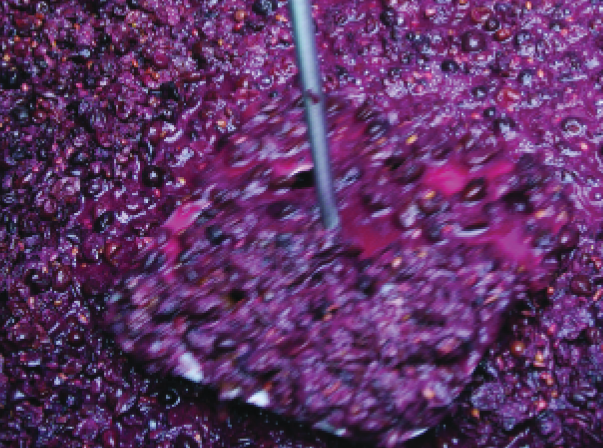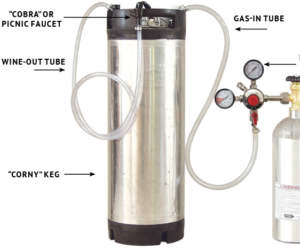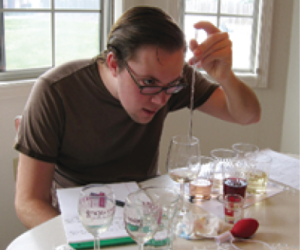
The concept of maceration is a rather simple one: Take crushed grapes (or fruit) and allow the grapes — skins, seeds, and stems — a period to soak with the grape juice. This can be a matter of hours or weeks. While maceration is only performed on certain wine styles, learning the hows and whys of maceration will help you improve your wines.
Maceration 101
To start the maceration process, oftentimes the grapes need to be crushed first (carbonic maceration being the exception to that rule). When dealing with red wines, fermentation will commence during the maceration process. Fermentation releases carbon dioxide that buoys the crushed grapes to the top of the mixture. These buoyed grapes are known as the cap. Winemakers want to keep these grapes submerged as best as possible. Often a specialty tool will be utilized to punch down the cap at least twice a day to keep these grapes in constant contact with the juice. There are other cap management systems, but for the hobbyist, punching down the cap is going to be the easiest and most effective method. The punch down process will continue for the duration of the fermentation process.
The main goal of the maceration process is to extract some of the key phenolic compounds found in the grapes such as anthocyanins (color), tannins, and many of the key aroma developing compounds. Duration and temperature are key factors that will guide winemakers in their decisions about the maceration process. Winemakers may choose to add certain enzymes to help facilitate key aspects of the maceration process. In general, the longer the maceration period, the more of these compounds will be extracted from the grape. But the Law of Diminishing Returns eventually comes into play since most of the extraction will occur early in the process and will diminish as maceration continues until extending any further will not gain the winemaker any more beneficial phenolic compounds.
This technique is most utilized by winemakers for red wines since this process is responsible for color development and creating structure in the wine.
Temperature of the macerating grape-pulp mixture will also be one of the key factors that the winemaker will want to control in order to maximize this process. Warmer temperatures mean faster extraction rates. The duration of the maceration period will also vary depending on the winemaker’s goal. A need to change the temperature of the macerating grapes will often occur during longer macerations.
This technique is most utilized by winemakers for red wines since this process is responsible for color development and creating structure in the wine. Red wine maceration is often anywhere from one week to a month depending on the winemaker’s goal with the wine. White wines may also undergo a much more abbreviated maceration period, usually in a matter of hours and can last up to a day or two for more aromatic white wines like Gewürztraminer. Rosé-style wines may also be produced using red grapes with a shortened maceration period, a process known as saignée.
Types of Maceration
Not all macerations are created equal. The basic maceration for red wines would be to crush the grapes, add sulfite, let sit overnight, and then pitch yeast. After fermentation has ceased, the winemaker then sends the wine and grapes into a press to separate the wine from the pulp. But there are some other tweaks winemakers can utilize to this basic process to achieve different goals.
Cold-soak maceration: Often just called a “cold-soak,” this form of maceration occurs prior to the commencing of fermentation. Cold-soaking is most common among grape varieties with lower phenolic content such as Pinot Noir. As the name indicates, is it performed at cold temperatures, often between 40–50 °F (5–15 °C) to keep microbe activity down and oxidative reactions to a minimum. This is often done for roughly 4 days, but some winemakers well-versed in this technique may go up to two weeks. The benefits of cold-soaking are hotly debated among winemakers with many arguing that potential negative side effects outweigh any gains winemakers may achieve, especially at the small scale
of hobbists.
Extended maceration: Extended maceration is a period post-fermentation when the wine is left with the grapes to maximize phenolic extraction and help with color stabilization of the final wine. Often winemakers performing an extended maceration will know it is time to press off when all the grape pulp sinks to the bottom of the fermenter. One of the biggest pitfalls of extending the maceration period is battling against oxidation. To combat this winemakers often layer an inert gas such as carbon dioxide or argon on top of the wine, which acts as a buffer.
Carbonic maceration: This is a very specialized form of maceration and utilized to develop fruit-forward wines such as Beaujolais’ with low phenolic concentrations. These wines are known for their light body, fruity aromas, and are best consumed young. During carbonic maceration, the grapes are left uncrushed and are allowed to sit in carbon dioxide-filled tanks where fermentation begins inside the grapes by enzymes instead of yeast. When the alcohol content within the grapes reaches about 2%, the grapes will split open . . . this is at about one week. Winemakers will often press off at this time and finish the fermentation with yeast. With little contact time between the juice and grape skins, these wines are often light bodied. Daniel Pambianchi, in his book Techniques in Home Winemaking, advises hobby winemakers who want to utilize carbonic maceration to use roughly 25–50% of their total grapes while the remainder are macerated in the traditional method.







